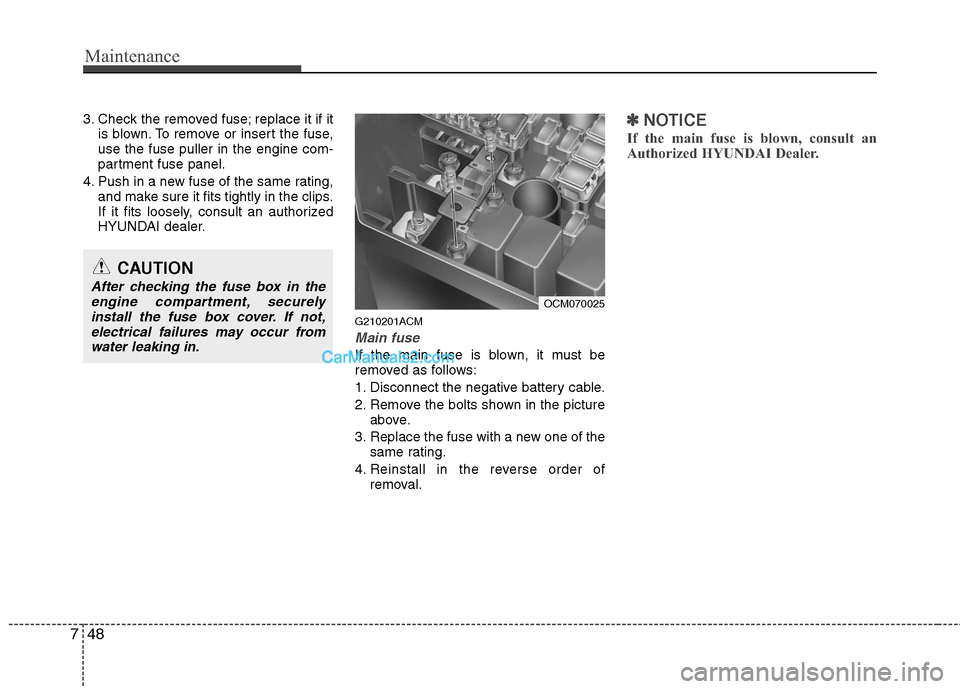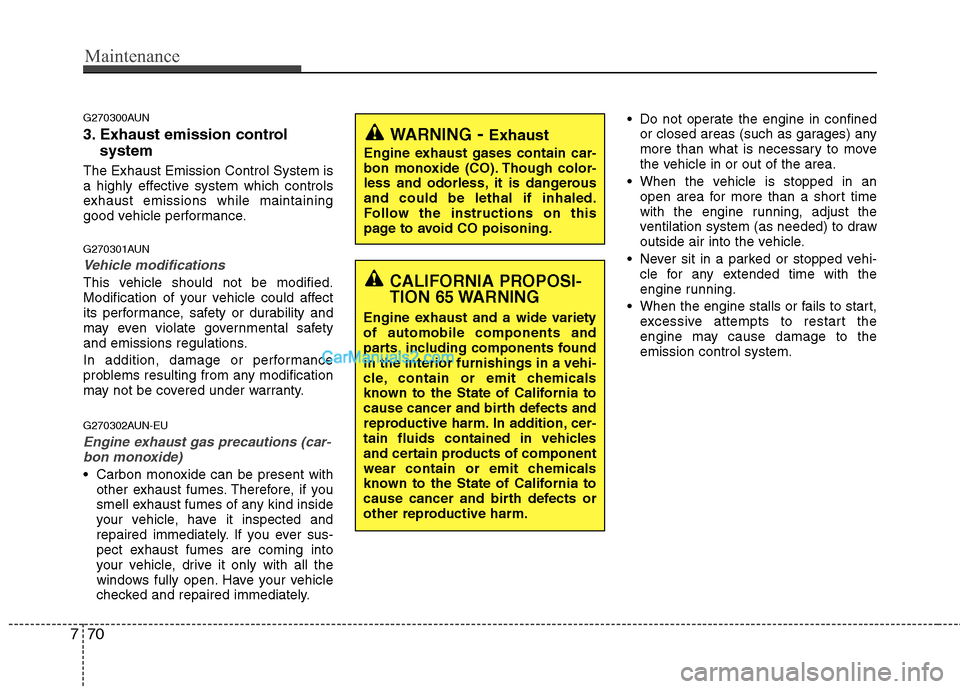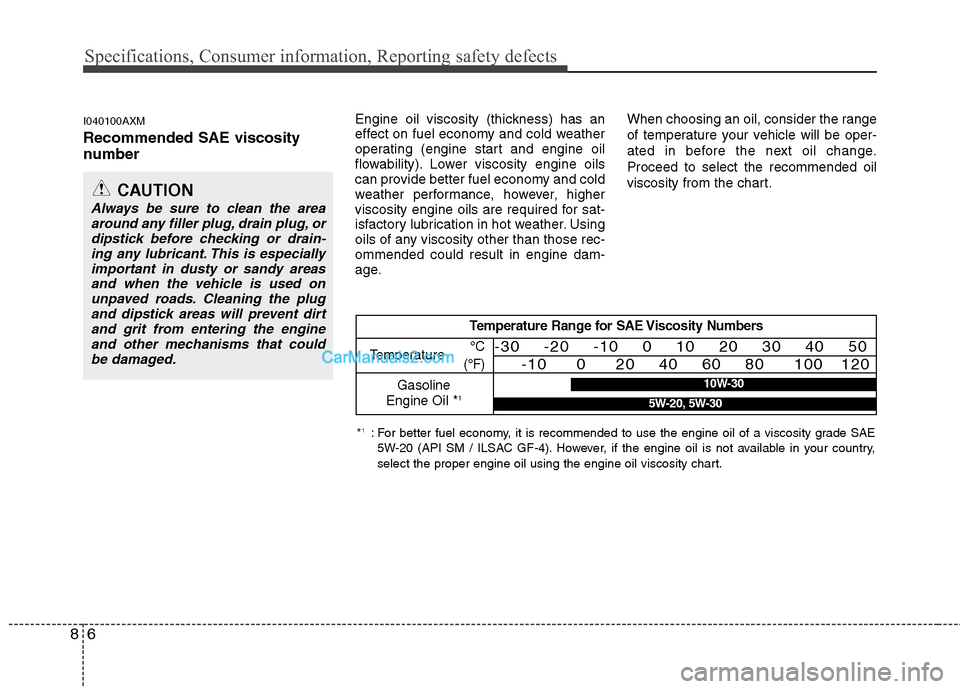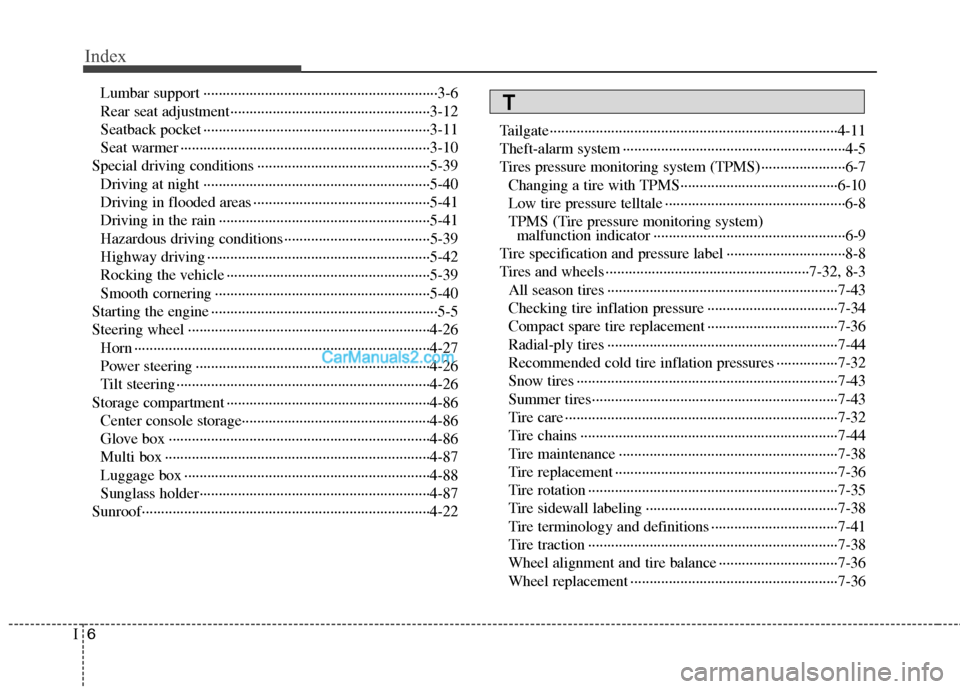2011 Hyundai Santa Fe check engine
[x] Cancel search: check enginePage 367 of 408

Maintenance
48
7
3. Check the removed fuse; replace it if it
is blown. To remove or insert the fuse,
use the fuse puller in the engine com-
partment fuse panel.
4. Push in a new fuse of the same rating, and make sure it fits tightly in the clips.
If it fits loosely, consult an authorized
HYUNDAI dealer.
G210201ACM
Main fuse
If the main fuse is blown, it must be
removed as follows:
1. Disconnect the negative battery cable.
2. Remove the bolts shown in the pictureabove.
3. Replace the fuse with a new one of the same rating.
4. Reinstall in the reverse order of removal.
✽ ✽NOTICE
If the main fuse is blown, consult an
Authorized HYUNDAI Dealer.
CAUTION
After checking the fuse box in the
engine compartment, securelyinstall the fuse box cover. If not,electrical failures may occur from water leaking in.
OCM070025
Page 371 of 408

Maintenance
52
7
Engine compartment
Description Fuse rating Protected component
ALT 175A FUSIBLE LINK - BLR, B+ 2, P/WDW, ESC 1, ESC 2
FUSE - DEICER, RR HTD, A/CON, FR FOG, H/LP LO LH, H/LP LO RH
BATT 30A Trailer Power Outlet
IGN 1 40A Ignition Switch (ACC, IG 1)
ESC 1 40A Multipurpose Check Connector, ESC Control Module
CON FAN 2 50A Condenser Fan Relay (High) ESC 2 20A ESC Control ModuleBLR 40A FUSE - BLOWER
P/WDW 40A Power Window Relay, FUSE - SAFETY PWR B+ 2 50A FUSE - P/SEAT, TPMS, RR A/CON, S/WARMER, S/ROOF, PDM 2, P/AMP, AC INVERTER, DRL
IGN 2 40A Ignition Switch (START, IG 2), Start Relay
B+ 1 50A FUSE - DR LOCK, HAZARD, ATM, PDM 1, STOP LP, POWER CONNECTOR (BCM 3, CLOCK
ROOM LP, AUDIO 1)
CON FAN 1 40A Condenser Fan Relay (Low) ECU MAIN 40A Engine Control Relay
1 DEICER 15A Front Wiper Deicer Relay
2 RR HTD 30A Rear Defogger Relay
3- --
4 H/LP LO RH 15A Head Lamp Low Relay (RH)
5 HORN 15A Horn Relay
Page 389 of 408

Maintenance
70
7
G270300AUN
3. Exhaust emission control
system
The Exhaust Emission Control System is
a highly effective system which controls
exhaust emissions while maintaining
good vehicle performance.
G270301AUN
Vehicle modifications
This vehicle should not be modified.
Modification of your vehicle could affect
its performance, safety or durability and
may even violate governmental safety
and emissions regulations.
In addition, damage or performance
problems resulting from any modification
may not be covered under warranty.
G270302AUN-EU
Engine exhaust gas precautions (car-
bon monoxide)
Carbon monoxide can be present with other exhaust fumes. Therefore, if you
smell exhaust fumes of any kind inside
your vehicle, have it inspected and
repaired immediately. If you ever sus-
pect exhaust fumes are coming into
your vehicle, drive it only with all the
windows fully open. Have your vehicle
checked and repaired immediately. Do not operate the engine in confined
or closed areas (such as garages) any
more than what is necessary to move
the vehicle in or out of the area.
When the vehicle is stopped in an open area for more than a short time
with the engine running, adjust the
ventilation system (as needed) to draw
outside air into the vehicle.
Never sit in a parked or stopped vehi- cle for any extended time with the
engine running.
When the engine stalls or fails to start, excessive attempts to restart the
engine may cause damage to the
emission control system.
WARNING- Exhaust
Engine exhaust gases contain car-
bon monoxide (CO). Though color-
less and odorless, it is dangerous
and could be lethal if inhaled.
Follow the instructions on this
page to avoid CO poisoning.
CALIFORNIA PROPOSI-
TION 65 WARNING
Engine exhaust and a wide variety
of automobile components and
parts, including components found
in the interior furnishings in a vehi-
cle, contain or emit chemicals
known to the State of California to
cause cancer and birth defects and
reproductive harm. In addition, cer-
tain fluids contained in vehicles
and certain products of component
wear contain or emit chemicals
known to the State of California to
cause cancer and birth defects or
other reproductive harm.
Page 397 of 408

Specifications, Consumer information, Reporting safety defects
6
8
I040100AXM
Recommended SAE viscosity
number
Engine oil viscosity (thickness) has an
effect on fuel economy and cold weather
operating (engine start and engine oil
flowability). Lower viscosity engine oils
can provide better fuel economy and cold
weather performance, however, higher
viscosity engine oils are required for sat-
isfactory lubrication in hot weather. Using
oils of any viscosity other than those rec-
ommended could result in engine dam-
age. When choosing an oil, consider the range
of temperature your vehicle will be oper-
ated in before the next oil change.
Proceed to select the recommended oil
viscosity from the chart.
CAUTION
Always be sure to clean the area
around any filler plug, drain plug, ordipstick before checking or drain-ing any lubricant. This is especially important in dusty or sandy areasand when the vehicle is used on unpaved roads. Cleaning the plugand dipstick areas will prevent dirtand grit from entering the engine and other mechanisms that couldbe damaged.
Temperature Range for SAE Viscosity Numbers
Temperature
Gasoline
Engine Oil *
1
°C
(°F)-30 -20 -10 0 10 20 30 40 50 -10 0 20 40 60 80 100 120
*1: For better fuel economy, it is recommended to use the engine oil of a viscosity grade SAE
5W-20 (API SM / ILSAC GF-4). However, if the engine oil is not available in your country,
select the proper engine oil using the engine oil viscosity chart.
10W-30
5W-20, 5W-30
Page 407 of 408

Index
6I
Lumbar support ··················\
··················\
··················\
·······3-6
Rear seat adjustment··················\
··················\
················3-12
Seatback pocket ··················\
··················\
··················\
·····3-11
Seat warmer ··················\
··················\
··················\
···········3-10
Special driving conditions ··················\
··················\
·········5-39
Driving at night ··················\
··················\
··················\
·····5-40
Driving in flooded areas ··················\
··················\
··········5-41
Driving in the rain ··················\
··················\
··················\
·5-41
Hazardous driving conditions ··················\
··················\
··5-39
Highway driving ··················\
··················\
··················\
····5-42
Rocking the vehicle ··················\
··················\
·················5-39\
Smooth cornering ··················\
··················\
··················\
··5-40
Starting the engine ··················\
··················\
··················\
·····5-5
Steering wheel ··················\
··················\
··················\
·········4-26 Horn ··················\
··················\
··················\
··················\
·····4-27
Power steering ··················\
··················\
··················\
·······4-26
Tilt steering ··················\
··················\
··················\
············4-26
Storage compartment ··················\
··················\
·················4-86\
Center console storage·············\
··················\
··················\
4-86
Glove box ··················\
··················\
··················\
··············4-86
Multi box ··················\
··················\
··················\
···············4-87
Luggage box ··················\
··················\
··················\
··········4-88
Sunglass holder··················\
··················\
··················\
······4-87
Sunroof··················\
··················\
··················\
··················\
···4-22 Tailgate··················\
··················\
··················\
··················\
···4-11
Theft-alarm system ··················\
··················\
··················\
····4-5
Tires pressure monitoring system (TPMS)··················\
····6-7
Changing a tire with TPMS··················\
··················\
·····6-10
Low tire pressure telltale ··················\
··················\
···········6-8
TPMS (Tire pressure monitoring system) malfunction indicator ··················\
··················\
··············6-9
Tire specification and pressure label ··················\
·············8-8
Tires and wheels ··················\
··················\
·················7-32\
, 8-3 All season tires ··················\
··················\
··················\
······7-43
Checking tire inflation pressure ··················\
················7-34
Compact spare tire replacement ··················\
················7-36
Radial-ply tires ··················\
··················\
··················\
······7-44
Recommended cold tire inflation pressures ················7-32
Snow tires ··················\
··················\
··················\
··············7-43
Summer tires··················\
··················\
··················\
··········7-43
Tire care ··················\
··················\
··················\
·················7-32\
Tire chains ··················\
··················\
··················\
·············7-44
Tire maintenance ··················\
··················\
··················\
···7-38
Tire replacement ··················\
··················\
··················\
····7-36
Tire rotation ··················\
··················\
··················\
···········7-35
Tire sidewall labeling ··················\
··················\
··············7-38
Tire terminology and definitions ··················\
···············7-41
Tire traction ··················\
··················\
··················\
···········7-38
Wheel alignment and tire balance ··················\
·············7-36
Wheel replacement ··················\
··················\
··················\
7-36T